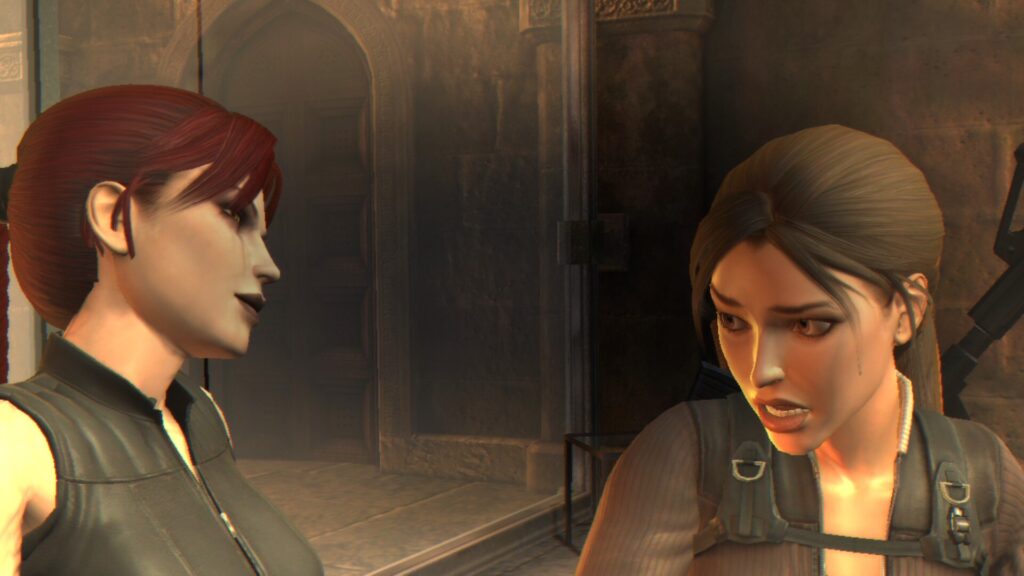I have a lot to say about this one, but let’s recap first. Crystal Dynamics’ trilogy came to a conclusion with Underworld, and the franchise needed a shot in the arm if it wanted to stay afloat. Lara herself went through so many plot arcs and tombs that it became somewhat dizzying. New franchises and novel gameplay mechanics came into vogue. Though Tomb Raider was still considered a large franchise, it grew more sedated compared to the likes of Halo and Call of Duty.
I’d like to focus on two franchise-launching titles in particular; Gears of War and Uncharted. Gears first arrived on the scene in 2006, exclusively for the Xbox 360. In it, you play a beefcake space marine shooting aliens behind chest-high walls yelling colloquialisms such as get sum! and one dead grub! This series brought the concept of push-forward, cover-based shooting to the mainstream, and of course it had plenty of imitators afterward. The other, Uncharted, is a close parallel to Tomb Raider. It’s essentially a carbon copy of Tomb Raider—from the adventuring protagonist down to the platforming and combat elements.
All this to say that Tomb Raider was outclassed and outmatched. A reimagining was needed, and Crystal Dynamics delivered in spades. Tomb Raider launched in early March 2013 to rapturous praise from gamers and critics alike. In fact, the lowest reputable score I could find for this game while researching was an 8/10.
So what made this game so special back then, and does it still hold up over ten years later? Let’s find out.
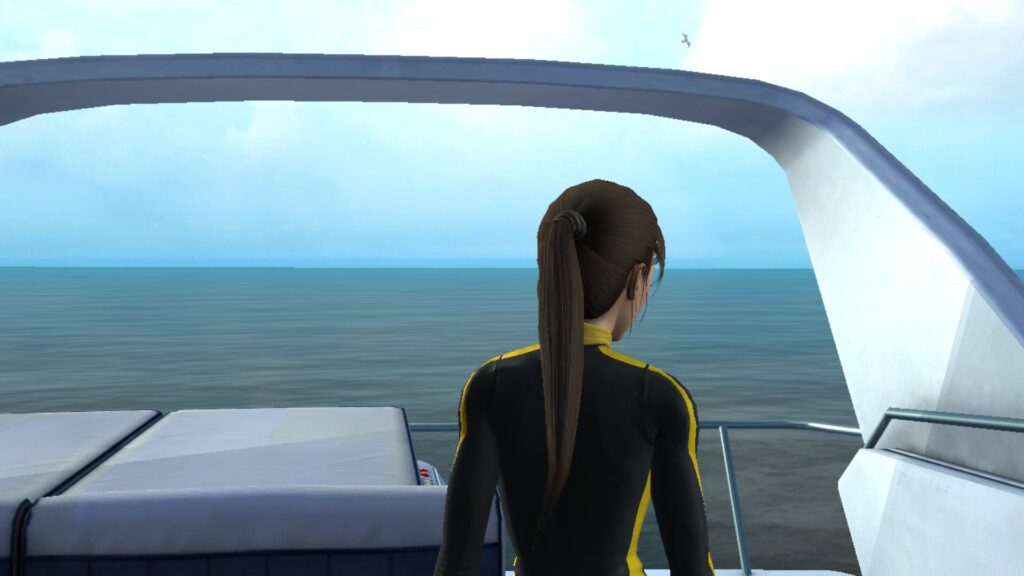
A Survivor is Born
When rebooting a game franchise—or any franchise really—it’s common to de-age the characters. The challenges they faced in previous installments so easily are now more daunting due to their inexperience. Tomb Raider is no different, placing Lara at the cusp of adulthood and on her first real adventure.
Looking at any screenshots or gameplay will tell you, briefly, a few things. The game aims for a grittier tone than its predecessors, and those artistic approaches apply to Lara herself. Gone are the days of the leather bodysuit or the evening dress with a slit from Mexico to Canada. Lara has only one outfit: a basic tank-top (sans baby blue) and unassuming pants.
Something I appreciate in games is when a character shows more wear and tear as the game progresses. A notable example of this is in Batman: Arkham Asylum, where Batman’s costume becomes more frayed and battered as the game progresses. That trick is employed here as well, to perhaps greater effect than in Batman’s game. The game’s survivor narrative and its unbroken, step-by-step progression lends itself well to Lara being in rags by the end of the story.
The story itself is more compelling than previous entries as well. Lara is part of an expedition traveling to a remote Japanese island in search of the lost kingdom of Yamatai, ruled by one Queen Himiko. A ragtag crew accompanies her. The standouts are James Whitman, a television archeologist on the brink of bankruptcy and Samantha Nishimura, a close friend of Lara’s.
The island is cursed, of course, and the ship they’re on is stranded in the opening minutes. From there it’s a story about survival, and Lara discovering the secrets of the island and its hostile inhabitants.
While the stakes of the story are nothing wholly groundbreaking the game’s new approach, appropriately summed up with the slogan A Survivor is Born in marketing, adds a weight to the conflict that simply wasn’t present before. Lara’s cool-girl, femacho attitude is completely erased in this entry. She’s vulnerable, and that shows in the first few minutes of the game.
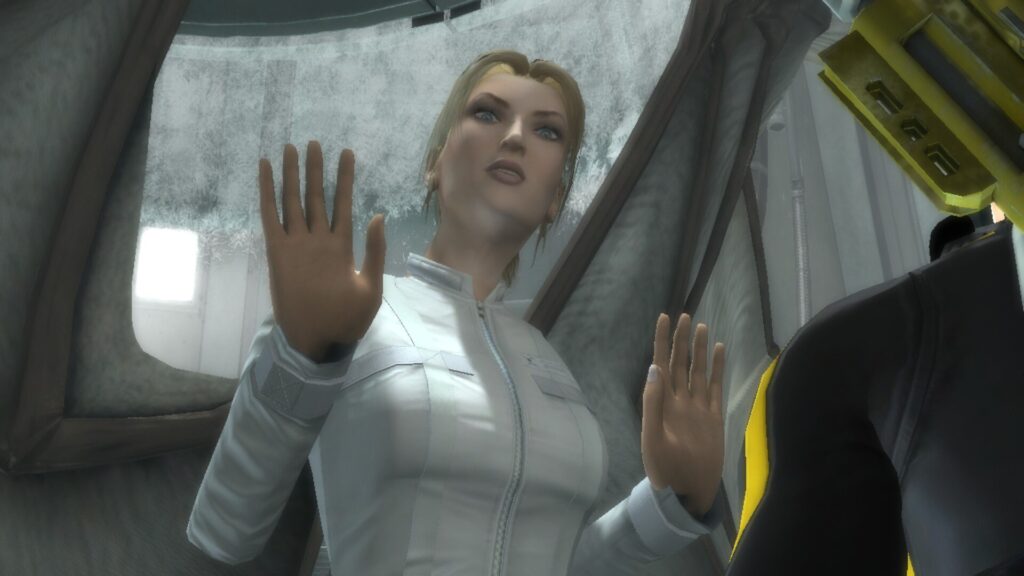
Brutality in Nature
When you first take control of Lara, she’s suspended upside down in a cave filled with rotting bodies and skeletons. Once you free her, she falls twenty feet onto a jagged branch which impales her side. It was the style at the time to include button mashing for any and all events requiring a character’s strength, from opening doors and chests to choking out an enemy. Tomb Raider maintains this trope, and I largely wasn’t a fan of it overall.
That said, when I’m being asked to mash X to rip a jagged rod out of Lara’s side, that complaint largely disappears due to the sheer squeamishness I felt. That extreme exertion, and its relative inability to be portrayed in gameplay, makes this one of the only times I’ll ever compliment this gameplay mechanic.
Mark my words.
The first enemies you’ll face are wolves, standard fare for Lara by this point.
But unlike the wolves of games past, these feel more aggressive, less comical. It’s not just the updated visuals, it’s the overall impression you get, one of stalking predators and not just random video game enemies. It might hinge on something I’ll talk about later, but for now keep the enemy’s intelligence in mind.
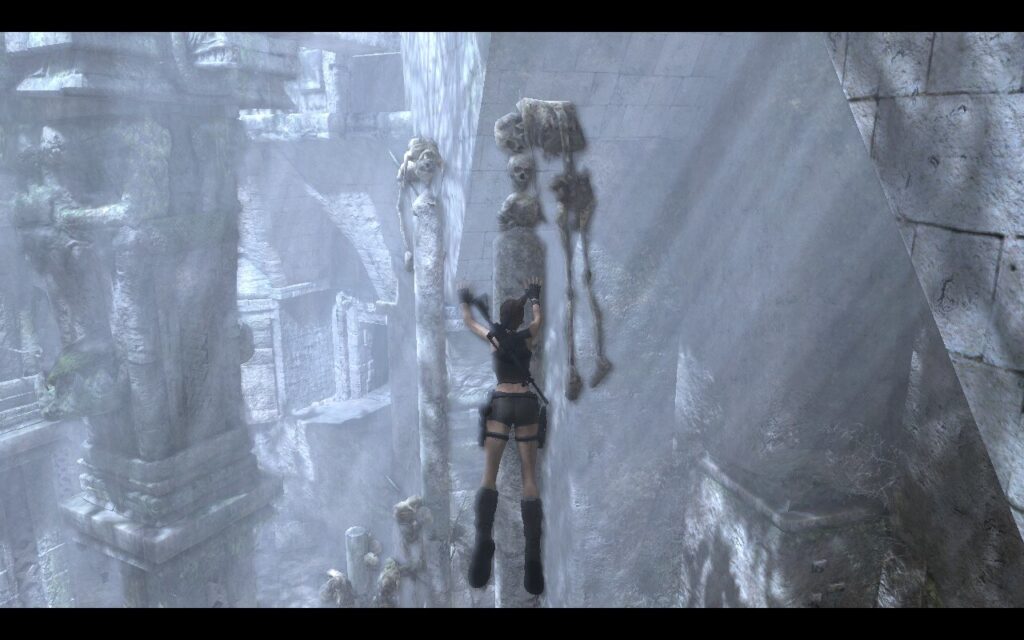
Ludonarrative Disaster
Human enemies come next, after Lara gets her hands on a few weapons. There are only four primary weapons to speak of; a pistol, shotgun, assault rifle, and bow. The bow became the trademark of the survivor trilogy, being featured in a good portion of the marketing running up to the game’s release. The weapons hit the right balance, giving you enough variety to account for most combat scenarios you’ll encounter in the game. Soon enough after getting your first weapon, you’re pitted against your first human opponent.
Lara wins and almost immediately has a minor breakdown over the fact that she’s just killed a man. This itself is not a bad idea. Lara is a recent college graduate and is on her first expedition in this rebooted canon. She’s distraught, shocked, terrified, and then the cutscene ends. That trauma is never brought up again for the rest of the game.
Instead players are rewarded for dispatching foes with headshots, stealth takedowns, brutal finishing moves, and kills in quick succession. The game flashes messages on screen such as HEADSHOT! +15 XP whenever you get one of these kills.
It’s a larger conversation to have about games as a medium. Aside from a small assortment of genres nearly all video games involve some sort of violence. Even family-friendly Mario has combat in his games. It’s cartoon and low-stakes, sure, but even Super Mario Bros. is kill or be killed. Mario isn’t portrayed as a real human, though. His only personal struggles are rescuing Peach from Bowser and go-karting. When your vulnerable protagonist isn’t accustomed to offing terrorists or the undead, there should be room for them to rest and deal with the trauma of having just killed someone.
Lara has this singular scene, then moves on entirely. Towards the end of the game she’s shouting at her foes, promising that she’ll kill all of them before she’s through. It’s shocking how much she changes without any introspection. And yes, I know I’m not the first person to point out this issue with the game, but it’s something that didn’t occur to me when I first played this reboot roughly ten years ago.
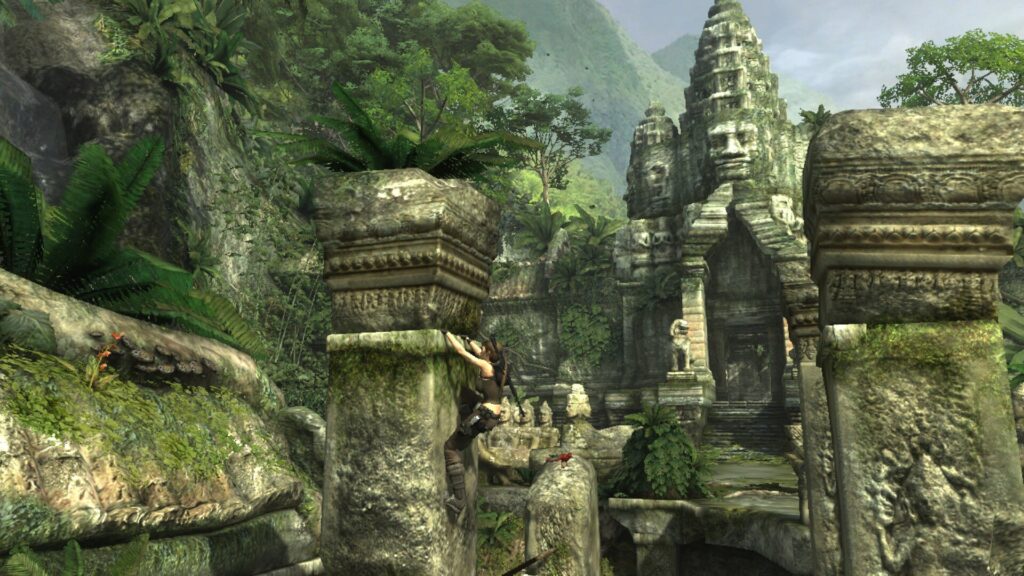
Tombs Optional
What did stick out to me, even then, were the tombs. So central they were to the prior games, with long stretches of those entries taking place entirely in the catacombs. Those expansive tombs were dialed back here in the reboot. Now there are seven tombs (eight if you include a downloadable extra), each of which take roughly five minutes to solve.
It’s underwhelming, to say the least. Each tomb has a single puzzle to solve to get at the goodies. One zip line later and you’re home free. To me it felt like some of the worst kinds of checklist-based content. It’s there, sure, but you don’t really need to do it in order to advance the story or get anything particularly cool or interesting. It’s a diversion plain and simple, lasting a maximum of forty minutes in a twelve-hour game.
These tombs also highlight a gripe I touched upon in Underworld. At the end of each tomb is a treasure chest that Lara opens Pulp Fiction style. She claims as her own before scooting out. As with Underworld Lara is destroying incredible discoveries either intentionally or by circumstance. It doesn’t lend well to a character who is hopefully taking her finds back to be preserved and displayed in a museum. You never really see what she does with those artifacts, other than store them in mallet space. One would hope she donates all her finds, but I don’t recall seeing any lore which would indicate as such.
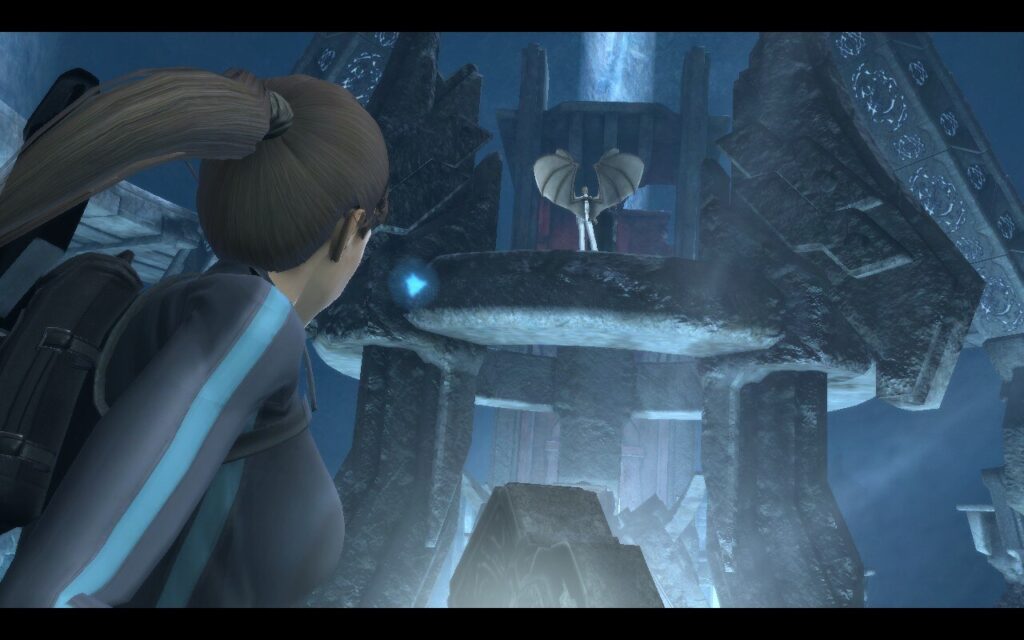
Mechanical Upgrades
Picture in your head three cars, all the same make and model. One is a classic from the sixties. The next is a newer car, but not too new—maybe the early 2000’s. The last is a brand new one, straight from the factory. Which one would you drive?
This may not be a perfect analogy, but I would imagine that most readers would either pick the classic model or the brand new one. People would generally experience something that’s either “retro” or “cutting-edge”, than somewhere in between those two. That’s how I feel about this reboot. Its gameplay mechanics and tropes have mostly fallen out of fashion, but they’re not yet old enough to be considered nostalgic.
I’ve already touched upon button mashing, which has become less prominent as the years march on. There’s a few others as well: regenerating health, cover- based combat with snappy gunplay, a mostly unnecessary XP/upgrade tree, and a tacked-on multiplayer mode.
You heard me right, this is the first mainline game in the franchise to include player vs player combat. The servers were all shut down years ago, though, and I only have other people’s footage and reviews of the time, which were lukewarm to negative.
Multiplayer aside, these were all huge upgrades for their time, and the game admittedly plays better than any of Crystal Dynamic’s previous entries. Giving the player free aim instead of the prior game’s lock-on shooting adds an extra sense of control of Lara’s actions. Cover-based gameplay was old hat by 2013, having been imitated and iterated on by loads of games since Gears of War came out seven years prior.
One aspect of the game which I think aged brilliantly is the enemy AI. Allegedly it was based off the AI in F.E.A.R., a horror shooter released in 2005. I recall hearing this some time ago, but during my research I couldn’t find any solid link between the two, so I am basing this solely on my own experiences while playing. Enemies react to your actions in a way that’s uncommon in other titles. They know when you’re reloading, and call out to each other during battle. Yes, I know it’s all just clever trickery, and the enemies don’t actually think during combat, but the illusion is solid enough to be believable in the moment.
The largest missed opportunity to me is the aforementioned regenerating health. Think about the game’s overarching concept. You have the A Survivor Is Born tagline along with the components of a crafting system and a grounded, realistic tone. Why not merge these even more? Have the player be forced to make splints to heal Lara’s broken bones or create makeshift bandages for cuts. Have a health bar and injuries which could hinder Lara’s ability to move or aim.
Metal Gear Solid 3 proved this kind of system could work, and I wish they tried something similar here.
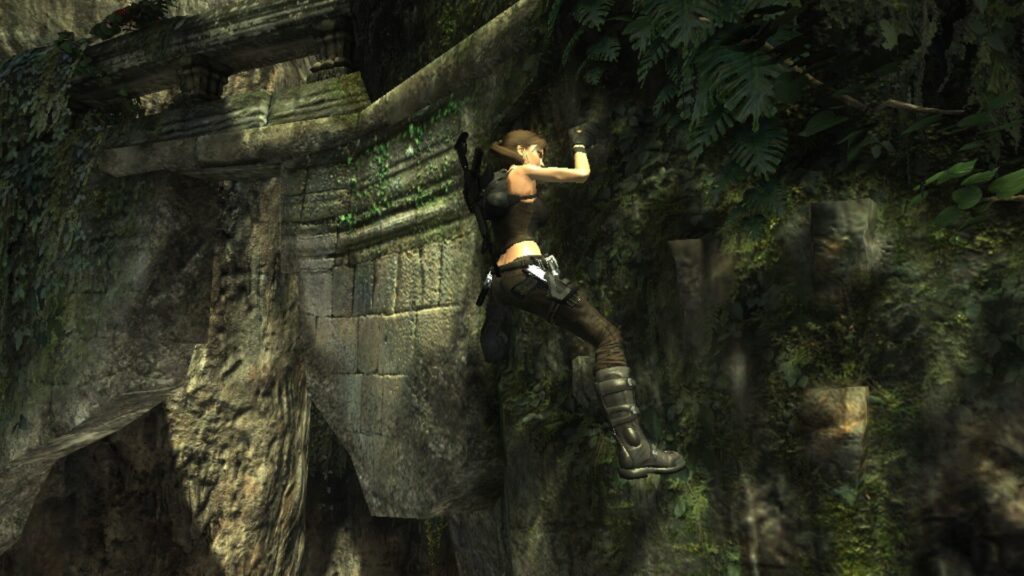
Putting it all Together
At the end of the day, Lara rescues her friend and the survivors escape together on an old WW2 boat after killing the evil that lives on the island. There isn’t any meaningful additional content to speak of. The only DLC released for this title was that one tomb and extra multiplayer content.
Overall, I feel like this game was exactly right for the time it was released in. The franchise had grown stale. It needed a new shot in the arm to stay relevant, and this 2013 entry was precisely what the doctor ordered. My view of the game has definitely changed since I played the game roughly ten years prior, skewing more negative. As I mentioned before, I think this game finds itself in a much more awkward spot than other games in the series. Not yet old enough to be a classic and not new enough to be novel. Maybe time will prove more kind, should we live in a world where cover-based shooters have become retro again.
Should you play Tomb Raider 2013? My answer would be a hesitant yes. It wears its seventh-generation stylings on its sleeve, but it’s one of the most compelling examples of those tropes that I’ve seen. You can also get it dirt cheap now. Steam prices for this game go as low as $3. If you can pick it up for that price, it’s a definite yes.
So Crystal Dynamics successfully rebooted the franchise. Now what? 2015 saw the release of Rise of the Tomb Raider, the second act in the Survivor Trilogy. We’re in the home stretch of games now, so I hope you stick around with me until next time!
